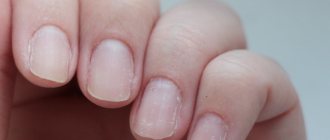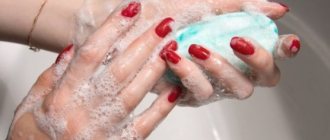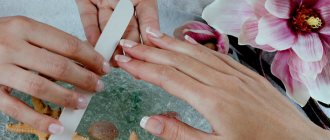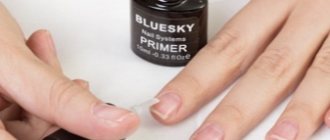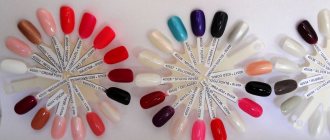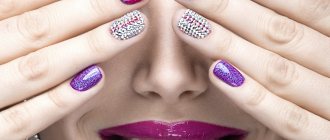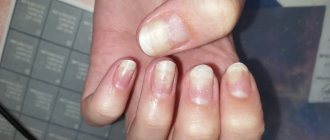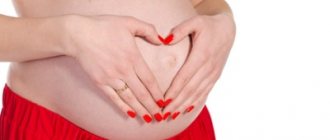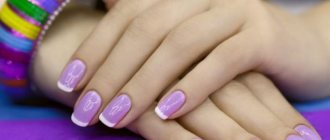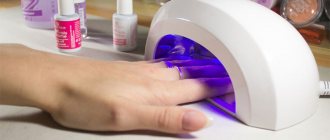Manicure: Pixabay A few years ago, the whole world was shocked by a new invention - shellac. Today, every girl uses a durable varnish coating, which has many advantages over regular varnish - shellac is easy to apply and lasts a long time, so the need to paint your nails every day has disappeared. But is the new trend in the nail industry really safe? Does shellac nail polish have any disadvantages? We read the opinions of experts and found the answers we were interested in.
The evolution of fashionable manicure
Nail polish, the composition of which was as close as possible to the modern one, appeared in the first half of the 20th century. The founder of the famous Revlon brand, Charles Revson, invented the formula for leave-in varnish and introduced colored nails that matched the shade of lipstick into fashion. By the end of the 20th century, unpainted nails of a woman who goes out into society became bad manners.
At the beginning of the third millennium, the nail industry began to actively offer extended nails - acrylic or gel, of various shapes and lengths. The varnish lasts longer on such nails, they are durable and well suited for nail art, and do not require daily polishing, shape correction or varnish coating.
However, artificial nails look rough and not entirely feminine. Therefore, the fashion for them passed quickly enough. Nowadays, well-groomed natural nails and manicures of the most incredible designs and a variety of shades are at the peak of popularity. Shellac, which combines a durable gel coating and regular colored varnish, has gained particular popularity.
Instructions for those who are trying shellac coating for the first time
Step-by-step instructions will teach you how to perform a single-color manicure using Shellac coating. Once you get the hang of it, you can try more complex design options.
Instructions on how to make shellac at home:
- First, we apply a base coat designed to protect the nails. First you need to paint the edges, then the middle. Then seal the tip of the nail. This will help the layers adhere better and achieve a thin application. This method is suitable not only for the base coating, but also for any other coating. It will take one minute to dry in the lamp.
- Apply the base in the same way, without coloring the tip. Try to stick to a thin layer. It takes one or two minutes to dry. If you notice that the gel polish is swollen, you will have to start all over again.
- If everything went well, it’s time to apply another layer of base. This will make the tone more saturated. The layer should be slightly thicker than the first. But if you want a translucent effect, then you can skip this point. Dry in a lamp for a couple of minutes.
- The top coating is the topmost and thickest of the layers. You need to dry it like the last one - only two minutes.
- Remove the resulting sticky layer with a sponge or lint-free cloth. Instead of a special remover, you can use regular alcohol, but then the manicure will become matte, not glossy.
The tutorial for applying shellac at home is very simple. However, don't worry if it doesn't work out the first time. Practice is key here.
What is Shellac?
In 2010, the American nail industry company with a thirty-year history, CND (Creative Nail Design), introduced its innovative product, which made a real revolution in the market - CND Shellac, translated as “natural varnish”. The first gel polish in the history of nail service won consumer recognition so quickly and confidently that the name became a household name.
Shellac (Shellac, Shilak) is a decorative coating for nails that combines the properties of varnish and gel. Being a pioneer in the nail industry market, he remains the most famous and in demand to this day. Gel polish helps you spend as little time as possible on caring for your hands. Its main advantage is that the manicure lasts for at least 2 weeks.
This durability is due to the presence of polymers in the composition, which, under the influence of UV radiation, form a durable film on the nails. The composition also contains monomers, active diluents and color pigments.
The manufacturer declares the composition of Shellac as 7 Free. This means it is free of toluene, dibutyl phthalate, formaldehyde resins, camphor, xylene and methyl ethyl ketone. Therefore, it is safe for the nail plate, does not cause allergies and does not emit a suffocating odor during application.
Benefit or harm?
Do you still not understand why shellac is so popular? It has a lot of advantages with a minimum number of disadvantages. As you know, pros and cons are inherent in everything and everyone, shellac gel polish is no exception.
Among the significant advantages:
- Long-term results (2 weeks).
- Durable coating (no peeling, chipping, or breakage).
- Improving the condition of the nail plates.
- Brand shine.
- Rich color palette.
- Possibility of creating manicure and pedicure.
- Suitable for all kinds of nail designs.
Just imagine, having done shellac, you forget about the need for touching up and filing for two weeks. You don't need to check the presentability of your manicure before leaving. This is an indispensable assistant for busy women, be it a businesswoman or a mother on maternity leave.
Are you going on vacation? Don't waste precious minutes of rest getting your nails looking divine after the seaside. Your marigolds will serve you faithfully for 14 days, sparkling in the sun without the colors fading. It doesn't matter whether you like classic French, bright nail art, crazy geometry or complex patterns.
The abundance of colors and the ability to create any design make shellac extremely popular, as it meets the requirements of everyone. This is a universal product for manicure and pedicure; in addition to fingers, gel polish is also suitable for feet.
There are so many pros that the cons are clearly lost against their background. But that doesn’t stop them from being them. You will be surprised, but for some, two hassle-free weeks of shellac are not enough. For such people, gel and acrylic extensions are favorites. Despite their effect in 3-4 weeks, in terms of quality they cannot be compared with the hero of our article, losing to him completely.
The disadvantages of shellac include:
- Less time result.
- No increase in nail length.
- Deterioration of the condition of the nail plates.
- Price.
If you look at the claims in order, then shellac is not intended to increase length. It is not an extension method. Its goal is a decorative coating coupled with strengthening nails, which allows them to grow their natural ones. Now, as for the deterioration. There is an opinion that after shellac nails deteriorate, they only become worse, more brittle and thinner. It's all about applying it correctly.
As already mentioned, errors during the procedure lead to the collapse of the entire nail event. That is why it is so important to study the original technology in detail and use high-quality branded products. The answer to the question is shellac harmful - no, if you approach the matter wisely. Shellac does not require washing, which ensures safety and prevents injury.
Acetone, which is widely used for removing homemade shellac, is unfavorable. In the salon, the master will offer you a remover liquid, and the negative acetone will certainly be diluted with nourishing vitamins and oils, which will reduce the harm from it to a minimum, thus preventing the nails from deteriorating.
The price of the issue varies depending on the city of your residence and the elite level of the salon. On average, this is 600 rubles. Taking into account the duration of the result, you need to pay about 1,200 per month, which not everyone can afford. Start from your own financial capabilities and desires. Why not, for example, do shellac once a month with a break? Or do it before going to the resort so you don't have to do a manicure there.
Advantages of Shellac
- Persistence. You can do housework, take a bath and swim in the sea - the coating will not be damaged for 2-3 weeks on your hands and 3-4 weeks as a pedicure on your feet.
- Wide palette of shades. You can apply one color or combine polishes as much as you like, getting your own, unique shade.
- Opportunities for the most daring nail art. A variety of designs on long and short nails, French nails, decoration with rhinestones, lace, fur, acrylic powder and foil are successfully made using Shellac.
- Safety. Shellac does not harm the nail plate, does not smell during coating, so it is not harmful to both the master and the client.
- The procedure for covering fingernails with Shellac takes up to half an hour. Afterwards, you can move freely and go about your business without fear of touching and smearing the not completely dry varnish in the case of a regular coating.
- You can do shellac home , without resorting to the help of nail service specialists, unlike gel or acrylic nail extensions.
MasterGitar.com
Many people have heard about shellac, but not everyone knows about its original use as a dye. The modern plastics industry began with shellac, the original goal of which was to replicate the basic properties of shellac with some additional qualities.
This article will not talk about modern nail polish or a Chicago rock band. We are talking about a natural substance, a waste product of special insects on special trees.
Initially, shellac was used not as a varnish coating for furniture, but as a dye that gave wood its characteristic shade. The use of shellac dye was mentioned in 250 AD. e. Roman writer Claudius Aelianus in his book on natural history. This method of wood processing remained relevant until the mid-1800s, when the English chemist Perkins discovered the first artificial aniline dye, which negated the production of natural ones.
The first mention of the use of shellac as a protective coating dates back to 1590 and is found in the work of an English writer who was in India and studied local customs. Excerpts from this narrative report the earliest uses of shellac known in history.
Describing the procedure for applying varnish to carpentry, he writes:
“they take a small amount of natural resin of the required color, and after heating, when it acquires certain properties, i.e. directly with hot varnish (molten mass), cover the entire surface of the wood being processed, as thick as a human fingernail. The resin penetrates the wood and hardens on it. Then, using straw or reed tow, the surface is polished so skillfully that not a single untreated area remains on it, and it shines like glass, caressing the eye. Polishing of the wood continues until a clear reflection appears on the surface. All household utensils are processed in this way in India.” — Shellac: extraction of raw materials, production, chemical research, sale and use. London, Sir I.Pitman & Sons, Ltd., 1935, p.3.
For a long time, shellac was an important export product between India and Western Europe.
From the early nineteenth century to the early twentieth, shellac was widely used as a protective coating for furniture. After which it began to be replaced by nitrocellulose varnish.
What is shellac
Shellac is nothing more than an organic secretion of a certain type of insect, Laccifer Lacca or Lacquer Bugs, one of the 2000 known species of such creatures, to protect their bodies.
Life cycle of a varnish bug
Lac beetles, about the size of an apple seed, attach in large numbers to special trees called lac host trees, in India these are mainly Dhak (Butea monosperma) and Ber tree (Ziziphus mauritiana).
They parasitize on these trees and secrete lacquer resin as a protective layer for their bodies, the source material for shellac.
These small creatures are a great destructive force, but a small number of them are not so dangerous.
The lacquer insect goes through four stages in its short six months of life - egg, larva, pupa and adult. The six-month cycle provides two harvests per year.
The female lays more than 100 eggs in the shape of a lacquer nest attached to a fresh twig of the lacquer tree. The eggs hatch into small and red larvae approximately 0.5 mm in length. The larvae leave the varnish nest and settle on the nearest branch to feed on it.
Each varnish larva is armed with a long proboscis, with which it draws sap from the tree. With the first meal, the process of releasing secretion from their body begins, which covers the body with a protective shell and prevents it from attack by predators. This secretion eventually forms a hard, resinous layer that almost completely covers the insect. Under the protection of this layer, after eight weeks the insect becomes an adult.
The male individual loses his proboscis, but antennae, paws, and a pair of wings appear. The men's cell is slightly longer than the women's and has a small round hatch. Through it, the male leaves the cell to fertilize the females, after which the male dies.
The female cell is rounded and remains attached to the branch. The individual retains its proboscis, but lacks wings and eyes, and exists as a shell-like organism.
The female is an egg-producing organism. As the individual grows, the release of varnish secretion and the size of the outer layer increase. After fourteen weeks, the insect contracts, allowing eggs to be laid. When they hatch, the larvae emerge and the process begins again.
The masonry contains a crimson liquid called lacquer dye, which resembles cochineal, an organic dye from similar insects that is used primarily in the food industry.
After the cycle ends and a new generation begins to emerge, the resin covering the branches is collected. The resin is peeled from the branches and dried before proceeding to obtain shellac. Some of the nests are saved for the production of a new crop.
Shellac production method
Once the trees are covered with varnish nests, the crop requires little or no attention until it is harvested. Harvesting involves scraping off shellac-rich twigs. The fresh harvest is left to dry before being sold. The collection process is usually carried out in rural areas, with small quantities going to local shops, the main sales being to manufactory agents.
The varnish material scraped from the branches is crude varnish raw material or varnish sticks (sticklac). They contain insect resin, lacquer dye and twigs. All this is crushed, washed, dried in the form of seeds. These lac seeds will then be processed manually or mechanically into shellac.
The quality and price of varnish sticks greatly depends on various factors, such as the type of tree, climate, harvest before or after the larvae emerge, and the method of drying and storage.
Shellac raw material purification process
The varnish sticks are crushed and sifted to remove sand and debris. Then they are washed, twigs and parts of insects are separated, and the varnish dye is also washed out.
Decaying insect bodies give a purple hue to the water, which can be concentrated into a dye.
The resin is dried and winnowed, then sifted and a commercial version of varnish seed is obtained. The varnish dust after sieving is known as molamma lac or varnish residue. The lacquer seed is heated by hand in long, narrow fabric bags. Charcoal is used. The shellac melts and slowly seeps through the fabric, leaving insect bodies and twigs inside the bag.
The residue inside the bag is another version of varnish residue called Kirilac. The filtered mass turns into plates approximately 0.5 mm thick and thinner depending on the skill of the master.
There are different types of shellac. Shellac varies in color from yellow to deep orange. Discolored shellac is called white.
Mechanically made shellac is melted using steam and pressing the raw molten lac using hydraulic presses or using solvents. The mechanical method is certainly more technologically advanced than the manual method.
Finally, the washed and cleaned shellac is dried, often in the open sun. Then stored in a cool, dry place until packaged for shipping.
Properties of shellac
Synthetic resins have replaced the once-used shellac in many applications, but public outcry against the use of unnatural and toxic compounds in foods may bring shellac back into the food industry as a preservative and coloring agent. Shellac itself is absolutely non-toxic.
Shellac was the base mixture for making gramophone records.
Shellac does not conduct electricity and was used until recently as an insulating material.
Shellac is hard, practically odorless when cool, but has a special smell when heated or melted.
The highest grade is light yellow; lower grades are dark orange-brown to almost dark red. Wax is removed from higher grades of shellac.
It is a powerful binder with low thermal conductivity. It is resistant to ultraviolet rays and has good adhesion, sticking to both porous wood and glossy smooth surfaces.
The surface is dry to touch in less than 15 minutes.
It can take on the consistency of clay or be thinned with a solvent. Shellac can be applied in an ultra-thin layer, and also washed off from the surface with an appropriate solvent. Shellac varieties
| SEED Lac, Kusmi Kusmi lacquer seed Neutral brown and untreated. Used for restoration and repair of antiques. Contains particles of bugs, wood, etc. Lac seed requires filtration after dissolution. |
| ButtonLac,Kusmi #1,Kusmi #2 Lacquered buttons Lacquered buttons are a unique shellac product used primarily for restoration. Gives a very hard finish, making it great for French polishing. There are two colors Kusmi #1 caramel amber and Kusmi #2 reddish brown. The difference is what time of year the harvest is harvested. |
| BysakhiButton Brownish Toned Made from Bysakhi lac seed (collected in summer from Palas and Ber trees) Bysakhi is a hard resin, brownish in color and is prepared manually by heating lac seed in cotton tubes. The resin seeps through the pores of the material and the shellac is formed into the shape of buttons. |
| GOSSAMER Machine Made TN Shellac is similar to yellow, very thin and dissolves quickly. Mechanical method of production. |
| LEMON Yellow/Orange Excellent general purpose shellac, light yellow in color. |
| GARNET (Dewaxed dewaxed) Rich red-brown hue |
| RUBY(red-amber, ruby) (removed from wax) Red-amber - used for mahogany, rosewood, and also as a dye to give a warm shade. |
| BLONDE (removed from wax) Almost transparent |
| SUPER BLONDE (removed from wax) Very transparent. |
| PLATINA (platinum) (removed from wax) Extra transparent |
Materials used from www.artisansofthevalley.com and www.shellac.net
How to take care of your nails when shellac is removed
Nails with this coating look bright and shine beautifully even in photos. Despite all the advantages, it also has certain disadvantages.
After removing the artificial coating, nails often become thinner and brittle. Therefore, they require special care. Here are a few options to consider:
- Sealing nails is one of the popular procedures performed in salons. The composition based on honey and wax perfectly restores the plate.
- Berry mask. Those berries that contain a lot of vitamin C are perfect for cooking. These are lingonberries and black currants. You can choose one or mix several types. Make a paste out of them, apply briefly to your nails, and then rinse with plain water.
- Many people know about the benefits of iodine mesh. Why not use it to strengthen your nail plates? Of course, it doesn't look very nice. Therefore, it is best to make a mesh of iodine at night, so that it has time to be completely absorbed.
- It is necessary to restore nails not only from the outside, but also from the inside. To keep them strong and healthy, first of all, you need to eat well. Consume more meat, fish, seafood or dairy products - anything that contains proteins or fatty acids.
- Olive oil. You just need to pour the oil into a small container and dip your fingers in there for a few minutes. If you do this every day, the effect will not be long in coming.
- Sea salt baths. A couple of tablespoons of this salt should be dissolved in one liter of plain water, and put your hands in it. It is advisable to do this procedure a couple of times a week to speed up the effect.
- Lemon juice is another good option for restoring and whitening nails. It needs to be rubbed into the plates, not dipped. Leave it on for a few minutes, then rinse off.

